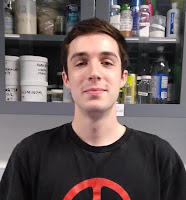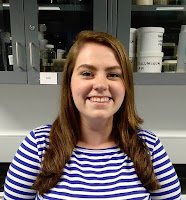A Brief Overview of the Hansen Solubility Parameters
(HSP) Theory
HSP theory is a
theory of solubility rooted in thermodynamics that predicts if a solvent will
dissolve a solute. Essentially, the theory boils down to “like dissolves like”.
The Hansen Solubility Parameters are based on the strength of a chemical’s
intermolecular forces:
- London dispersion forces, ẟD
- Dipole-dipole forces, ẟP
- Hydrogen bonding, ẟH
Each force is quantified by its strength. The three parameters are then mapped in 3D space (Hansen Space), with the solvents represented as points, and the solute represented as a large sphere with an experimentally determined radius (as seen in the photo to the left). If a solvent falls within the sphere, it will dissolve the solute, and if it falls outside the sphere, it will not dissolve the solute. The closer the solvent is to the center of the sphere, the better the dissolution. This is called the Relative Energy Distance (RED) which is calculated in the HSPiP analytical software. The RED is the distance from a solvent to the center of the sphere divided by the radius of the sphere. A RED less than 1 indicates that the solvent is within the sphere and the lower the RED, the more effective the dissolution will be.
HSPiP contains the very useful Solvent Optimizer function. With
this theory, there is proportional mixing of the solvents, meaning that if you
mix two solvents together in a 1:1 ratio, the new HSP value will be an average
of the two HSP values. This gives potential for two solvents outside of the
sphere to be mixed together to have a new HSP within the sphere and work as a
replacement solvent. The goal is to mix solvents together in a ratio that
obtains the lowest RED, which the program does based on the solvents you input.
This means that if a hazardous chemical cleans a soil from a surface, we can
blend together safer solvents to achieve the same level cleanliness.
Case Study
Students were given the following scenario to try and find a
safer substitution using HSPiP:
A company is manufacturing parts by using a polyethylene terephthalate (PET) mold that needs to be dissolved. The company is using methylene chloride at room temperature to dissolve the PET mold. The workers are using proper gloves and eye protection, but no masks. Find a solvent or create a solvent blend using HSPiP that can optimally dissolve the PET mold and is safer for the workers to use.
A company is manufacturing parts by using a polyethylene terephthalate (PET) mold that needs to be dissolved. The company is using methylene chloride at room temperature to dissolve the PET mold. The workers are using proper gloves and eye protection, but no masks. Find a solvent or create a solvent blend using HSPiP that can optimally dissolve the PET mold and is safer for the workers to use.
Details
PET: (18.2, 6.4, 6.6) Radius: 4
PET: (18.2, 6.4, 6.6) Radius: 4
·
Methylene chloride’s RED to PET is 0.65
·
Make sure your solvents are liquid at room
temperature
·
Make sure the solvents are safe for the workers
·
You do not need to worry about cost of the
solvents for this challenge
The submitted replacements were ranked based on their
effectiveness, smallest distance to PET, and their safety scores, using TURI’s
P2OASys (https://p2oasys.turi.org/).
Submissions
|
Blend
|
D
|
P
|
H
|
RED
|
P2OASys Score
|
|
Benzyl
Acetoacetate (100%)
|
18.04
|
6.47
|
6.21
|
0.13
|
4.300
|
|
18
|
6.4
|
6.5
|
0.1
|
4.200
|
|
|
Butyl Benzoate (50%)
Glycerol Triactetate (50%)
|
17.4
|
5.1
|
7.3
|
0.54
|
3.950
|
|
Benzyl Benzoate (18%) Butyl
Benzoate (24%) Dimethyl Isosorbide (58%)
|
18.2
|
6.4
|
6.6
|
0
|
4.184
|
|
Butyl Benzoate (83%)
Caprolactone (8%)
2-Propanol (9%)
|
18.1
|
6.4
|
6.6
|
0.05
|
4.314
|
|
Butyl Benzoate (82%)
γ-Butyrolactone (7%)
2-Phenoxy Ethanol (11%)
|
18.2
|
6.4
|
6.6
|
0
|
4.254
|
Solvents Proposed:
Benzyl Acetoacetate (CAS: 5396-89-4)
Hazards: SDS indicates none,
through a deeper search we found it was a skin irritant, eye irritant, and
hazardous to aquatic life.
Butyl Benzoate (CAS: 136-60-7)
Hazards: Acute toxicity, Oral
(Category 4), Skin irritation (Category 2), Eye irritation (Category 2A)
Dimethyl Isosorbide (CAS: 5306-85-4)
Hazards: None
Benzyl Benzoate (CAS: 120-51-4)
Hazards: Acute toxicity, Oral
(Category 4), Acute aquatic toxicity (Category 1), Chronic aquatic toxicity
(Category 1)
Glycerol Triactetate (CAS: 102-76-1)
Hazards: None
Caprolactone (CAS: 502-44-3)
Hazards:
Eye irritation (Category 2A)
2-Propanol (CAS: 67-63-0)
Hazards:
Flammable liquids (Category 2), Eye irritation (Category 2A), Specific target
organ toxicity - single exposure (Category 3), Central nervous system
γ-Butyrolactone (CAS: 96-48-0)
Hazards:
Acute toxicity, Oral (Category 4), Serious eye damage (Category 1), Specific
target organ toxicity - single exposure (Category 3), Central nervous system
2-Phenoxy Ethanol (CAS: 122-99-6)
Hazards:
Acute toxicity, Oral (Category 4),
Eye irritation (Category 2A)
Winners
 |
| Dan Anspach and Lily Green 2/3 of the winning team! |
1st Place: Dan, Lily, and Justin
Benzyl Benzoate (18%) Butyl Benzoate (24%) Dimethyl Isosorbide (58%)
Benzyl Benzoate (18%) Butyl Benzoate (24%) Dimethyl Isosorbide (58%)
2nd Place: Aaron
Butyl Benzoate (50%) Dimethyl Isosorbide (50%)
Butyl Benzoate (50%) Dimethyl Isosorbide (50%)
3rd Place: Diana and Sabrina
Benzyl Acetoacetate (100%)
Benzyl Acetoacetate (100%)
All teams participating created safer blends that had and
RED less than 0.65; congrats to everyone for learning! Students cited that the
hardest part of the challenge was finding solvents within the program that were
safe and spent most of their time looking at SDS sheets and toxicology
databases. Our first place winners received a $50 Visa gift card and trophies.
They will be presenting on their blends at a presentation to the whole TURI
staff.
Our November/December HSPiP Challenge will be focusing on
a real solvent replacement for TCE for electroplating. The winners of the next
challenge will then purchase their solvents and test to see if their solution
will work in a realistic setting. They will also receive a $50 Visa gift card
and trophies. Stay tuned!


























